How to Test DNA for Family History (and get more from your results!)

Anyone can Test DNA for Family History
From Diahan Southard, Your DNA Guide here at Genealogy Gems: DNA testing is one of the most personal ways to get involved in your family history. You have DNA from your parents, who have DNA from their parents, and so it goes, back into your greats and great-greats. The technology of genetic genealogy is all about tapping into that DNA record and pulling out information that might be useful in your family history. DNA can do this for you in two ways:
- First, it connects you to places. These are places where your ancestors came from a hundred, a thousand, or tens of thousands of years ago.
- Second, it connects you to people. These people are your genetic cousins, other living people who have taken the same DNA test that you took. The similarities in your DNA tell you that you share a common ancestor. You can then examine the pedigree of your match and work with them to help verify your family history, or give you new ideas about who your ancestors might be.
Types of DNA Tests for Family History
You have three choices of DNA tests, each with its own unique purpose.
YDNA – Essentially, if you want to know about a male ancestor, you need to find a direct male descendant to be tested. So if I want to know about my 3X great grandfather Morris Mitchell, I need to find Morris’s son’s son’s son, etc. until I find a living male with the Mitchell surname who can be tested on the Y chromosome DNA (mtDNA) test at Family Tree DNA.
mtDNA – If I want to know about a female ancestor, let’s say Mary West, I need to find Mary’s daughter’s daughter’s daughter’s etc. child (male or female) to take the mitochondrial DNA (mtDNA) from Family Tree DNA.
Autosomal DNA – For any ancestor, male or female, who is fewer than 5 generations from you, you can take the autosomal DNA test at either Family Tree DNA, AncestryDNA, 23andMe, or MyHeritage to find out more about that individual. Remember with the autosomal DNA that you always want to test the oldest generation first. So anyone who does not have both of their parents living should take the autosomal DNA test.
Companies that can Test DNA for Family History
There are several companies that test DNA for family history including:
Each of these companies is offering a very similar kind of test, but each has their own unique tools and databases. Decide which company you want to test with by evaluating things like:
- their website accessibility
- their company goals
- and especially the size of their database
You can see a table comparing these companies here. The MyHeritage test is new, and is not on the chart yet, but will be soon.
Great (DNA) Expectations
The best thing you can do when setting out on your genetic genealogy journey is set good expectations. You can expect that the test will document the personal genetics of the person who takes it. By so doing, you are creating another genealogy record that will last for generations. This test will link you to your ancestors via your cousins. That means that you may take the test looking for ancestors, but what you get are cousins. It will take traditional genealogy work to turn those cousin connections into ancestral connections. Above buy prescription medicine overseas all, expect that this is a growing industry, and what we know today is different than what we will know tomorrow, so enjoy the journey!
DNA Resources
There are several comprehensive books on Genetic Genealogy out there. However, for the layman who just wants to understand their DNA test results and get some additional value from them, an entire book full of scientific explanations can be overwhelming and daunting. The following email is one we receive regularly:
Could you direct me to an understandable publication which explains dna results in layman’ terms ?
Thank you
Anne B.
Genetic Genealogy for the Layman
I encouraged Diahan to immediately get to work putting her easy-to-follow explanations into a new series of quick reference guides. Genealogy Gems Publications is proud to publish her wonderful series of DNA quick reference guides for understanding your DNA results in plain language, and helping you get the most out of the investment you made in testing.
Start Here to Jump into Using DNA for Genealogy
Diahan has a regular segment on my free Genealogy Gems Podcast where she answers your questions and provides invaluable insights into the latest in genetic genealogy. You can also find the complete archive of DNA articles at Genealogy Gems by clicking here. The most recent will appear first and then scroll down to read through the past articles.
For those who have tested with Ancestry DNA
- Autosomal DNA for the Genealogist
- Understanding Ancestry DNA
- Organizing Your DNA Matches
- Next Steps: Working with Your Autosomal Matches
Mix and Match for Genetic Genealogy
The beauty of the DNA quick reference guide series is that you can mix and match the guides to perfectly suit the testing you have done. We’ve published Diahan’s guides that delve into the testing companies FamilyTreeDNA and 23andMe, as well as the other tests available such as Mitochondrial (for your maternal line – both men and women can take this test) and YDNA (for your paternal line – only men take this test.)
Take Your DNA Test Results to the Next Level
If you’ve already tested and feel like you have a good foundation, then I highly recommend Diahan’s Advanced DNA Bundle. It will take your DNA test results to the next level by instructing you on the heart of what matters in plain English.
DNA in the News
As of March 28, 2017, AncestryDNA customers can see if their ancestors belonged to about 300 different Genetic Communities, small migratory groups that can be identified by DNA. In the next free Genealogy Gems podcast episode #202, you will learn more about it straight from Ancestry’s Chief Scientific Officer, Catherine Ball. For more information on Genetic Communities, watch the video below:
Want to get tested? Get your AncestryDNA test here.
How German Address Books at Ancestry.com are Helping Bust Brick Walls
My genealogy research looks a lot like yours. Some family tree lines go back to pre-Revolutionary War. Other lines are richly researched well into the early 19th century.
And then there’s THAT family line. You know the one I mean. The one where the courthouse containing the records we need has burned down, or the records were microfilmed ages ago but are still sitting in the FamilySearch granite vault due to copyright issues. Or worst of all, it appears the needed records just don’t exist.
Don’t let these obstacles allow you to give up hope.

Every day, new records are being discovered and digitized. Records that have been languishing in a copyright stalemate might suddenly be cleared for publication. Or a cousin could contact you out of the blue and has the letters your grandmother sent hers. We never know when the records we’ve been waiting for, searching for, and yearning for, will bubble up to the surface.
Today I’m happy to share my story of a recent breakthrough that I never saw coming. Follow along with me as I take newly unearthed rocks and use tools to turn them into sparkling gems.
This is Almost Embarrassing
My one, agonizing family line that stops short in its tracks ends with my great grandfather Gustave Sporowski.
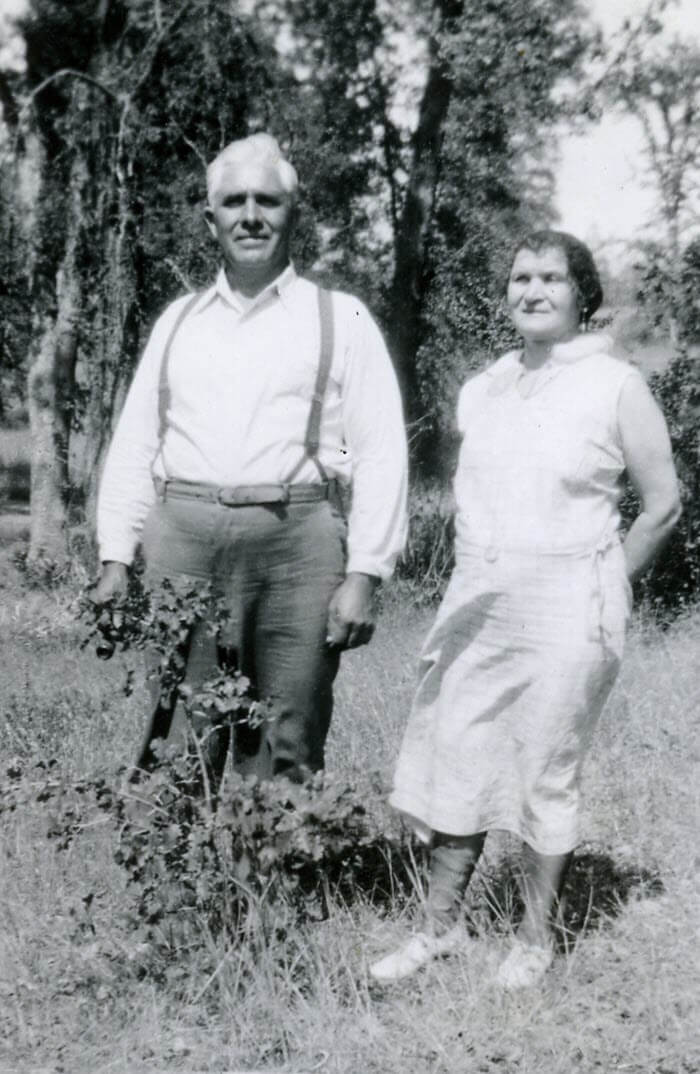
Gustave and Louise Sporowski (personal collection)
It’s almost embarrassing to admit. I’ve been at this nearly my whole life, and genealogy is my career for goodness sake! But there it is, a family tree with lovely far-reaching limbs except for this little stub of a branch sticking out on my maternal grandmother’s side.
I was about eight years old the first time I asked my grandma about her parents and their families. (Yes, this genealogy obsession goes back that far with me!) I still have the original page of cryptic notes she scratched out for me during that conversation.

Excerpt from Grandma’s original notes. (Personal collection)
She had several nuggets of information about her mother’s family. However, when it came to her father Gustave, she only recalled that he was the youngest of seven brothers. No names came to mind. I’ve always felt that if I could just identify some of the brothers, one of them may have records that provide more details about their parents.
According to his Petition for Naturalization, Gustave Sporowksi and Louise Nikolowski were married in LutgenDortmund, Germany. This indicated that both moved west from East Prussia before emigrating. While I knew Louise’s immediate family were in the LutgenDortmund area as well, I had no idea whether Gustave moved there on his own or with his family.
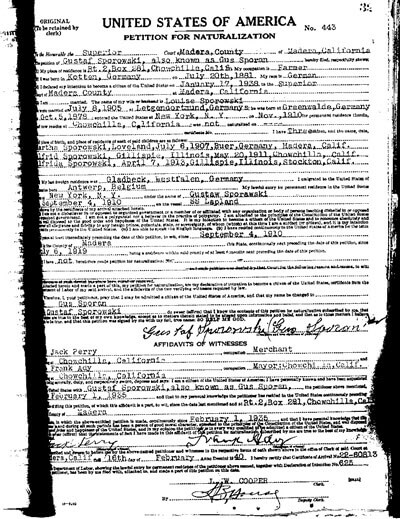
Gustave Sporowski’s Petition for Naturalization.
Gus (as he was later known) emigrated from Germany in 1910, landing at Ellis Island. He toiled in the coal mines of Gillespie, Illinois, and eventually earned enough money to move his wife and children west to California in 1918.
After filing his papers and years of waiting, he proudly became a U.S. citizen in 1940.
On that paperwork, he clearly states his birthplace as Kotten, Germany. You won’t find this location on a map today. In 1881, the year he was born, the area was East Prussia. I remember the hours I spent with gazeteers many years ago trying to locate that little village nestled just within the border of Kreis Johannisburg. Being so close to the border meant that he could have attended church there or in a neighboring district.
The records in the area are scarce, and today the entire area is in Poland.
Surprisingly, the records situation is quite the opposite with his wife Louise, also from East Prussia. She lived not far away in Kreis Ortelsburg, and the records for the church her family attended in Gruenwald are plentiful. I’ve managed to go many more generations back with her family.
And so, poor Gus alone sits in my family tree.
I periodically search to see if there’s anything new that has surfaced, but to no avail. I even hired a professional genealogical firm to review my work and suggest new avenues. I guess it is good news to hear you’ve pursued all known available leads, but it’s not very rewarding.
Over time, we tend to revisit tough cases like this less frequently. They become quiet. Digital dust begins to settle on the computer files.
And then it all changes.
German Address Books at Ancestry.com
I regularly make the rounds of the various genealogy websites, making note of new additions to their online collections. I typically publish the updates on a weekly basis here on the Genealogy Gems blog. It makes my day when readers like you comment or email, bursting with excitement about how one of the collections I mentioned busted their brick wall. I love my job.
This week I’m the one who is bursting!
It started simply enough. My third stop on my regular records round-up tour was Ancestry.com. The list of new records was particularly robust this week. The word “Germany” always catches my eye, and the second item on the list jumped out at me:
Germany and Surrounding Areas, Address Books, 1815-1974
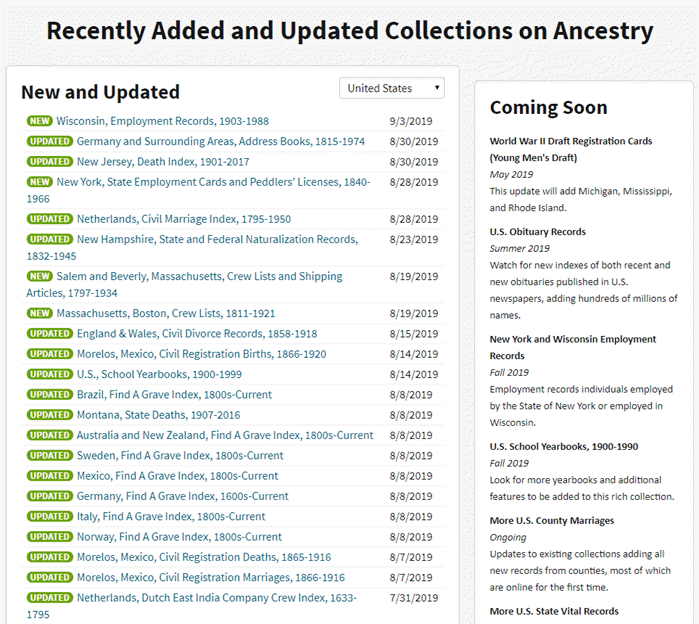
“Recently Added and Updated Collections on Ancestry,” Ancestry.com (http://www.ancestry.com : accessed 05 Sept 2019)
I should have had a healthy dose of skepticism that I would be fortunate enough to find anything. But to be perfectly honest, I felt instinctively that I would! Have you ever just had that feeling that your ancestors are sitting right there ready to be found? If you’ve been researching your family history for a while, then I’m guessing you have. Such a nice feeling, isn’t it?
So, I clicked, and I simply entered Sporowski in the last name field and clicked Search.
Experience has taught me that there haven’t been a lot of folks through history with this surname, so I’m interested in taking a look at anyone who pops up in the results. And yippie aye oh, did they ever pop up!
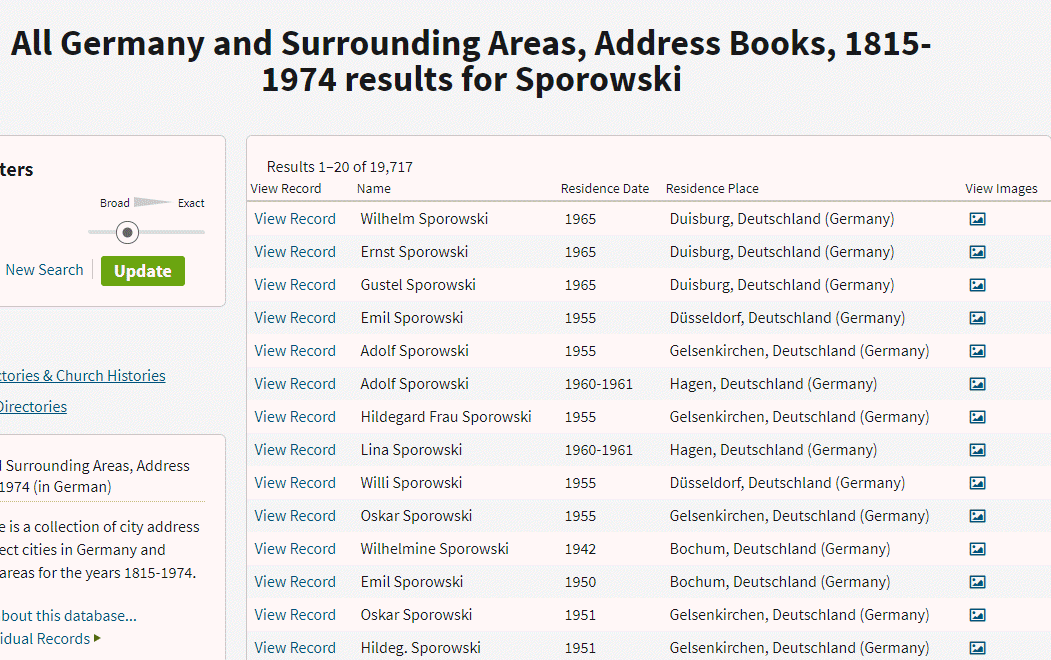
“All Germany and Surrounding Areas, Address Books, 1915-1974,” Ancestry.com (http://www.ancestry.com : accessed 05 Sept 2019)
The results list include 31 people with the surname of Sporowski!
These names came from the pages of address books much like the city directories so common in the U.S. Since this collection was new to me, I took a moment to read up on the history.
______________________________
GENEALOGY RESEARCH TIP: Learning the History of the Genealogy Record Collection
To truly understand what you are looking at when reviewing search results, we need to acquaint ourselves with the history of the collection.
- Why was it created?
- What does it include?
- What does it not include?
Look to the left of the search results and click Learn more about this database.
It’s definitely worth clicking this link because the next page may also include a listing of Related Data Collections, some of which you might not be aware. These could prove very useful, picking up the pace to finding more records.
In the case of foreign language records, look for a link to the Resource Center for that country. There you may find translation help and tips for interpreting handwriting and difficult-to-read script.
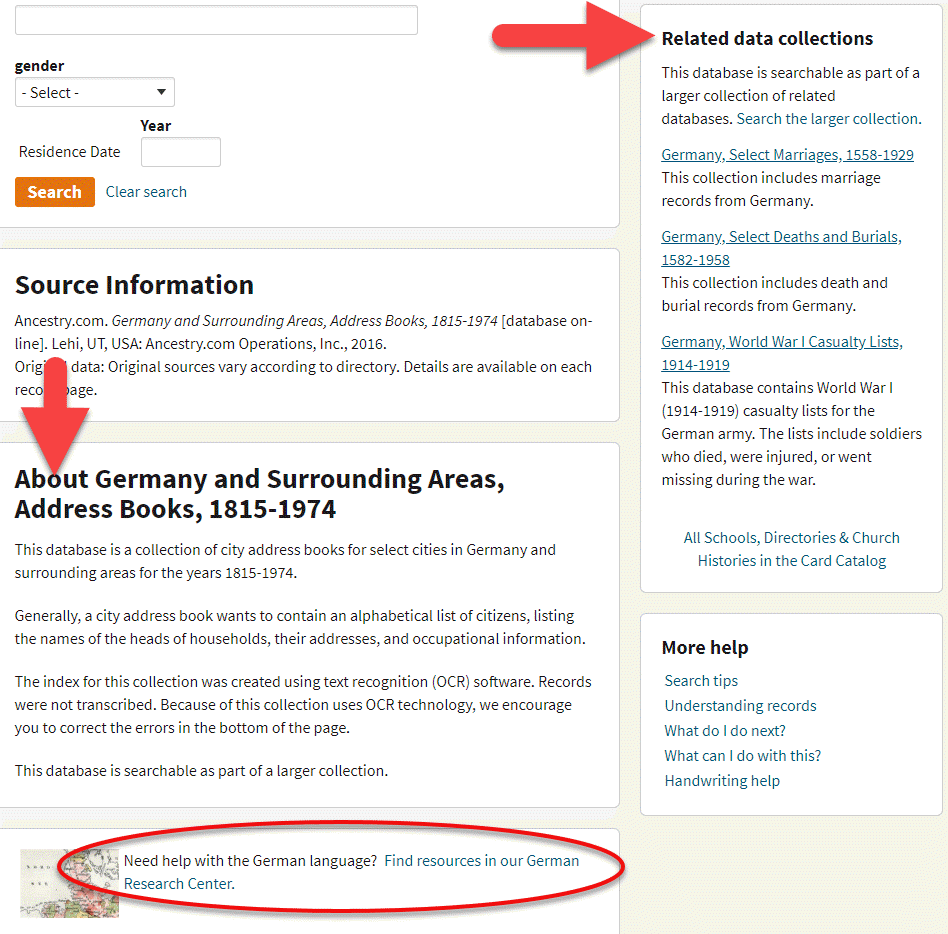
Ancestry Help Features
______________________________
On the Learn more about this database page, I learned some important things about these search results.
First, not every citizen was listed. Only heads of households were included. This means that wives and children would not appear. I did find some widows, though, because they were the head of their household.
Second, Optical Character Recognition (OCR) was used on this collection. Ancestry suggests looking for errors and providing corrections. But this information about OCR also implies something even more important to the genealogist. We must keep in mind that OCR is not perfect. In this case, I planned on browsing the collection after reviewing the search results to ensure I didn’t miss anyone. This would include targeting people listed in the “S” section of directories for towns I might expect the family to be.
I was particularly thrilled to see the name “Emil Sporowski” on the list.
Several months ago I found a World War I Casualty list from a newspaper published in 1918.

On it was listed Emil Sporowski and he was from the village of Kotten. This was the first mention of Gustave’s birthplace in the record of another Sporowski that I had ever found. So, you can imagine my delight as I stared at his name in the address book search results.
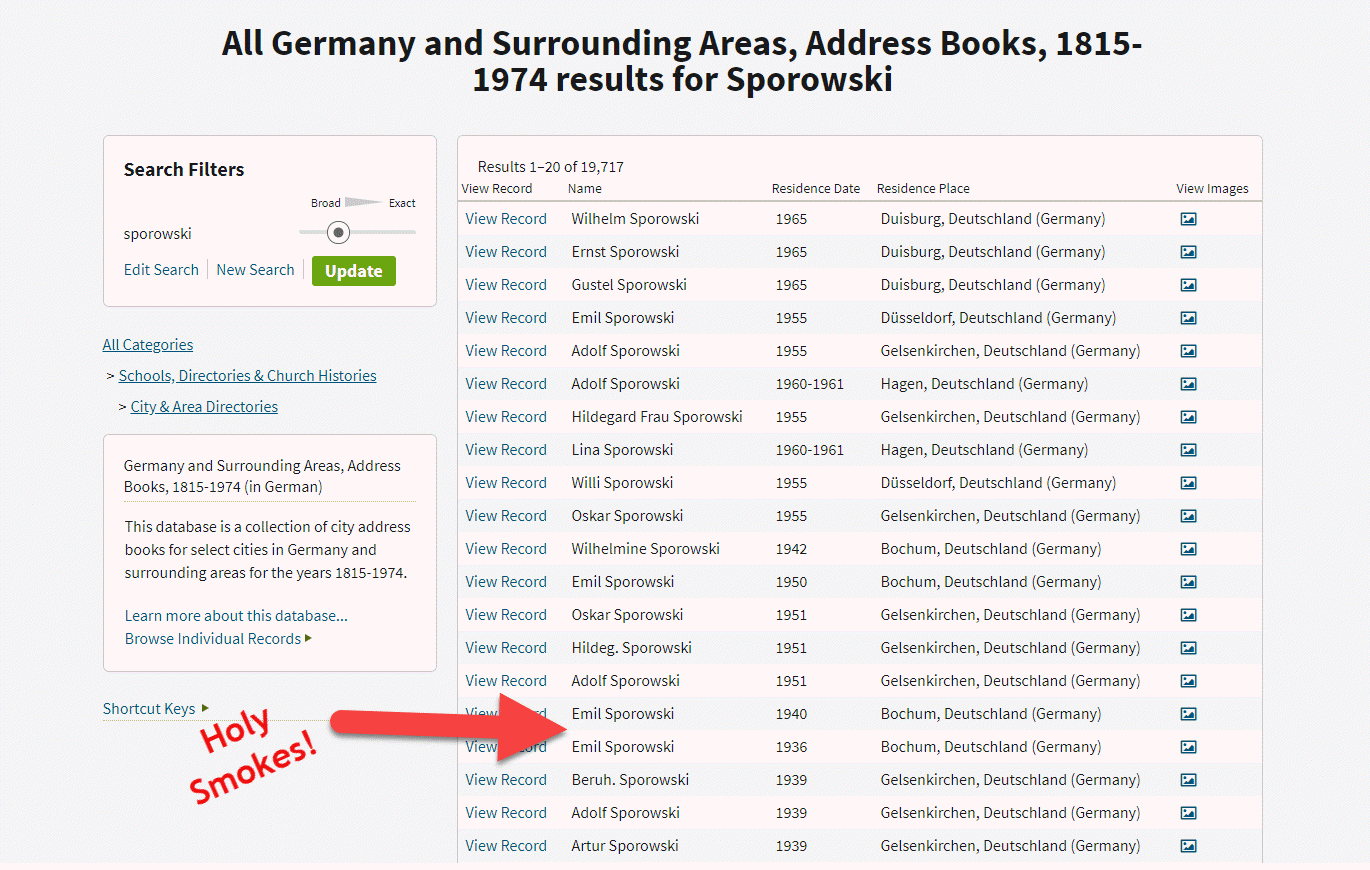
“All Germany and Surrounding Areas, Address Books, 1915-1974,” Ancestry.com (http://www.ancestry.com : accessed 05 Sept 2019)
The icing on that cake was that he was listed in the address book of Bochum. That town name was very familiar to me because I had seen it on a few old family photos in Louise Sporowski’s photo album. Although the photos did not have names written on them, I could easily identify the folks who had the facial characteristics of Louise Nikolowski’s clan, and those sporting the large eyes with heavy lids like Gus.
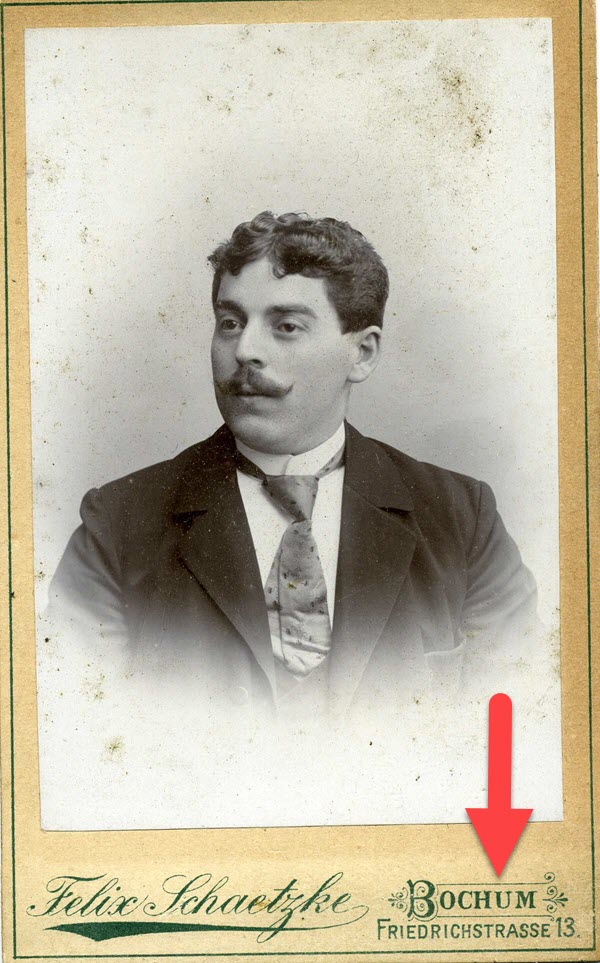
Photo from Louise Nikolowski’s photo album.
Spreading the German Addresses Out with Spreadsheets
With one and a half pages delivering a total of 31 Sporowski names, I knew I had some work ahead of me to tease them apart. This got me thinking of Genealogy Gems Podcast episode that I’m currently working on, which features a conversation with professional genealogist Cari Taplin. When I asked Cari how she organizes her data, she told me that she uses spreadsheets. I’m not typically a spreadsheet kind of gal, but in this case, I could see the benefits. Spreadsheets offer a way to get everybody on one page. And with the power of Filters and Sorting you slice and dice the data with ease. My first sort was by town.
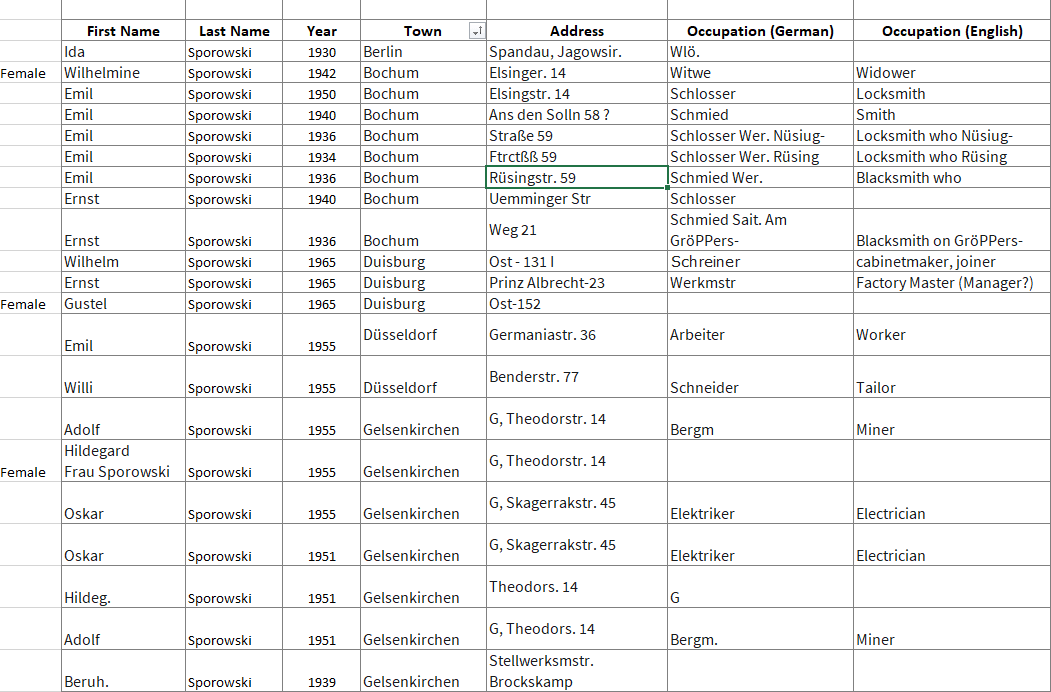
My Excel spreadsheet tracking German Address Books search results at Ancestry.com
______________________________
GENEALOGY RESEARCH TIP: Free Genealogy Gems Download
Click here to download the simple yet effective spreadsheet I used for this research project. If you find your German ancestors in this collection, it’s ready to use. Otherwise, feel free to modify to suit your needs in a similar situation.
______________________________
As you can see in the spreadsheet, these address books include occupations. For example, Emil was listed both as a Schmied and a Schlosser. A simple way to add the English translation to my spreadsheet was to go to Google.com and search Google Translate. Words and phrases can be translated right from the results page.
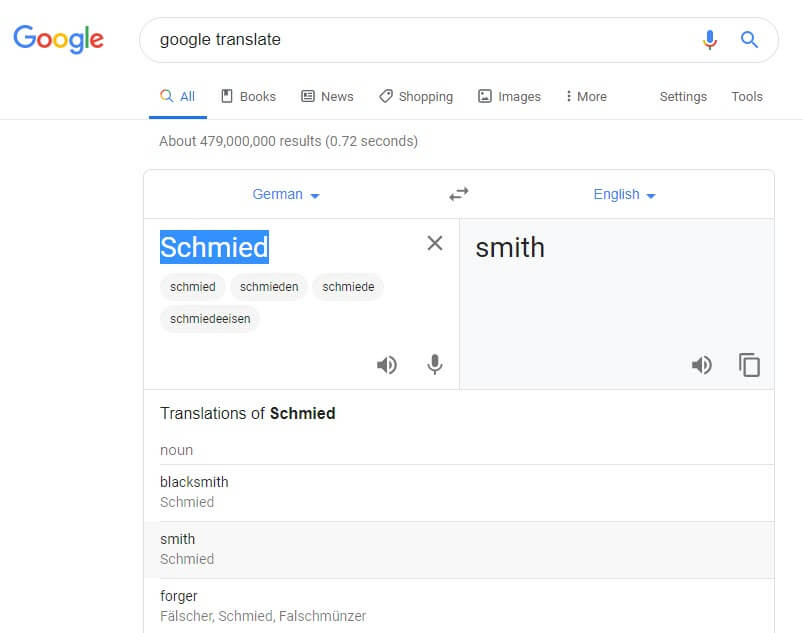
Translating the Occupation found in the German Address Books using Google Translate (Available at https://translate.google.com. Accessed 05 Sept 2019)
You can also find several websites listing German occupations by Googling old german occupations.
I quickly ran into abbreviations that were representing German words. For example, Lina Sporowski is listed with as Wwe .
A Google search of german occupations abbreviations didn’t bring a website to the top of the list that actually included abbreviations. However, by adding one of the abbreviations to the search such as “Wwe.” it easily retrieved web pages actually featuring abbreviations.
One of the top results was by friend of the podcast Katherine Schober and her SK Translations blog post called 19 Most Common Abbreviations in German Genealogy.
______________________________
GENEALOGY RESEARCH TIP: Use Search Operators when Googling
Notice that I placed the abbreviation in quotation marks when adding it to my Google search query. Quotation marks serve as search operators, and they tell Google some very important information about the word or phrase they surround.
- The quotation marks tell Google that this word or phrase must appear in every search result. (If you’ve ever googled several words only to find that some results include some of the words, and other results include others, this will solve your problem.)
- They also tell Google that the word(s) MUST be spelled exactly the way it appears on each search result. This is particularly helpful when searching an abbreviation like Wwe. which isn’t actually a word. Without the quotation marks, you will likely get a response from Google at the top of the search results page asking you if you meant something else.
Click here to receive my free ebook including all the most common Google search operators when you sign up for my free newsletter (which is always chock full of goodies).
______________________________
Katherine was my guest on Genealogy Gems Premium Podcast Episode #151 available exclusively to our Premium eLearning Members. She’s also written a couple of articles for Genealogy Gems on German translation:
When to Use Google Translate for Genealogy–And Best Translation Websites for When You Don’t
Translating German Genealogy Records: 9 Top German Translation Websites
Deciphering Place Names Just Got Easier
I’ve written an article you may find helpful not only for translation but also to help you with pronunciation called How to Pronounce Names: Google Translate and Name Pronunciation Tools.
As it turns out, Wwe. stands for Widow. This tells me that Lina’s husband was deceased by 1961.
Finding the German Addresses in Google Earth
The most glorious things found in these old address books are the addresses themselves!
Google Earth is the perfect tool to not only find the locations but clarify the addresses. Many were abbreviated, but Google Earth made quick work of the task.
Unlike other free Google Tools, Google Earth is available in a variety of forms:
- Free downloadable software
- Google Earth in the Chrome Web browser
- A mobile app
Each has powerful geographic features, but I always recommend using the software. The web version and app don’t have all the tools available in the software. All versions require an internet connection. You can download the software here.
In the Google Earth search box I typed in the address. Don’t worry if you don’t have the full address or if you think it may be spelled incorrectly. Google Earth will deliver a results list of all the best options that most closely match.
In my case, reliable Google Earth not only gave me complete addresses, but also the correct German letters.
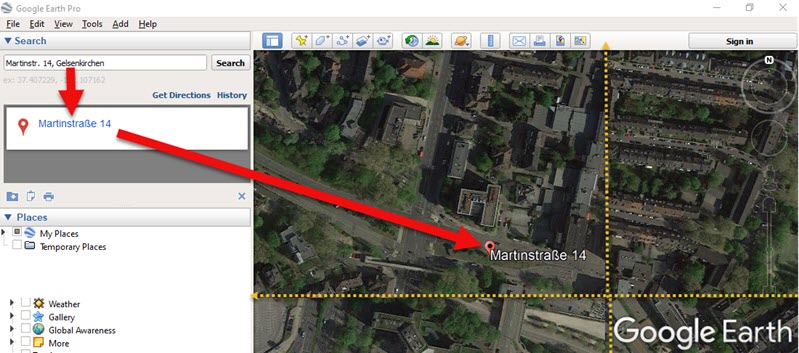
Finding the full name of the German address. (Map data ©2019 Google Earth software: accessed 6 Sep 2019)
Soon I found myself virtually standing outside their homes thanks to Google Earth’s Street View feature!
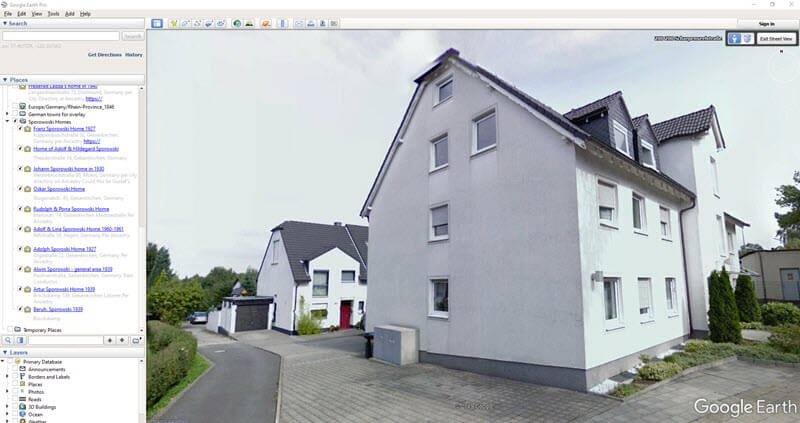
Home of my German ancestor found in Google Earth in Street View. (Map data ©2019 Google Earth software: accessed 6 Sep 2019)
Here’s how to use Street View in Google Earth:
- Zoom in close to the location
- Click on the Street View icon in the upper right corner (near the zoom tool)
- Drag the icon over the map and blue lines will appear where Street View is available
- Drop the icon directly on the line right next to the house
- Use the arrow keys on your keyboard to navigate in Street View or simply use your mouse to drag the screen
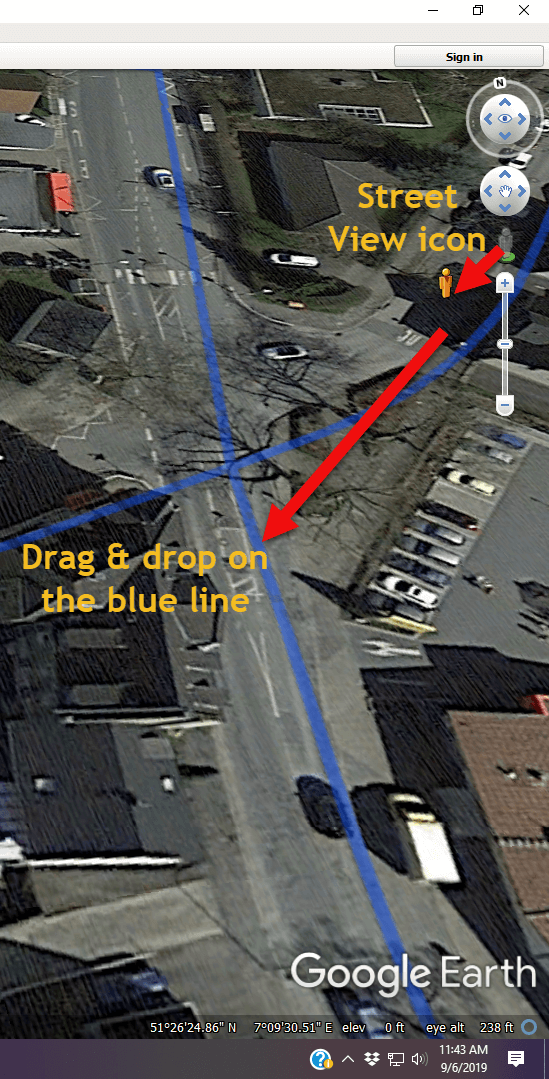
Using Google Earth Street View. (Map data ©2019 Google Earth software: accessed 6 Sep 2019)
I went through the entire list. As I found each location in Google Earth, I checked it off on the spreadsheet.
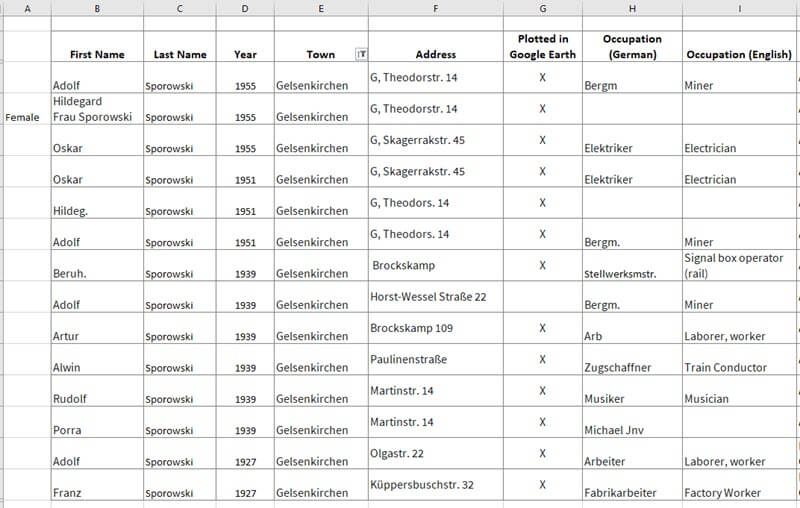
Addresses found in German Address Books at Ancestry.com marked in the spreadsheet
GENEALOGY RESEARCH TIP: Create a Folder in Google Earth
When you have several locations like this to plot, I recommend creating a folder in the Places panel in Google Earth. It’s super easy to do and will help you stay organized. Here’s how:
- Right-click (PC) on the MyPlaces icon at the top of the Places panel (left side of the Google Earth screen)
- Select Add > Folder in the pop-up menu
- A New Folder dialog box will appear
- Type the name of your folder
- Click OK to close the folder
- You can drag and drop the folder wherever you want it in the Places panel
- Click to select the folder before placing your Placemarks. That way each placemark will go in that folder. But don’t worry, if you get a placemark in the wrong spot, just drag and drop it into the folder.
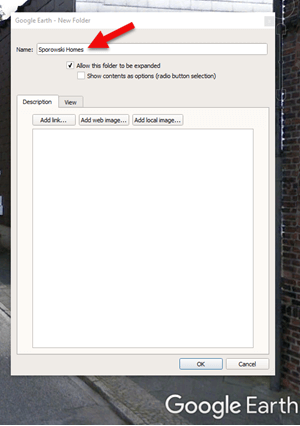
Creating a Folder for the German Addresses found at Ancestry.com (Map data ©2019 Google Earth software: accessed 6 Sep 2019)
It didn’t take long to build quite a nice collection of Sporowski homes in Germany!
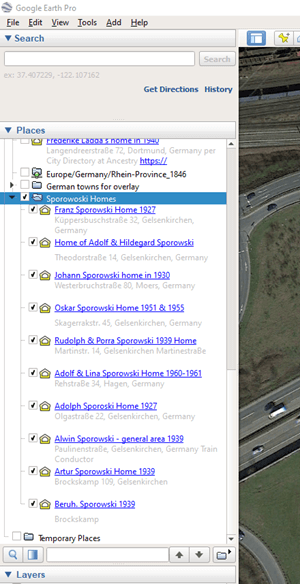
German addresses in the Places panel. (Map data ©2019 Google Earth software: accessed 6 Sep 2019)
The beauty of Google Earth as that you can start to visualize your data in a whole new way. Zooming out reveals these new findings within the context of previous location-based research I had done on related families. As you can see in the image below, all the Sporowskis that I found in the German Address books at Ancestry.com are clustered just five miles from where photos were taken that appear in Louise Sporowski’s photo album.
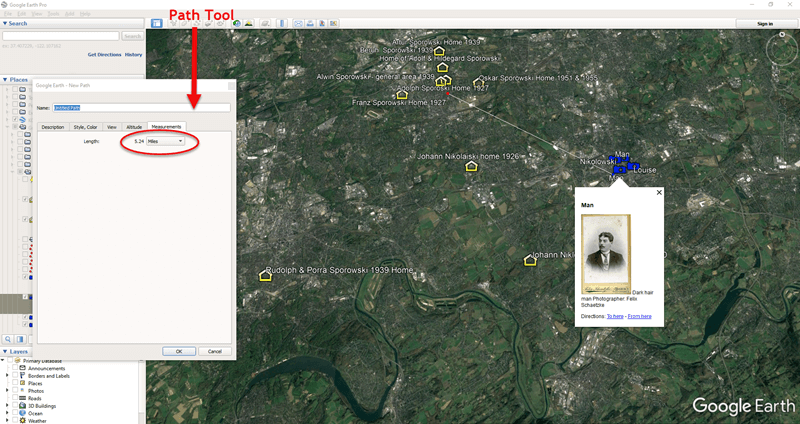
Data Visualization in Google Earth: My German Families found in Address Books. (Map data ©2019 Google Earth software: accessed 6 Sep 2019)
I’ve Only Just Begun to Discover my German Ancestors at Ancestry.com
We’ve covered a lot of ground today, but this is just the beginning. There are additional sources to track down, timelines to create, photos to match up with locations, and so much more. In many ways, I’ve only scratched the surface of possibilities. But I need to stop writing so I can keep searching! 😊
I hope you’ve enjoyed taking this journey with me. Did you pick up some gems along the way that you are excited to use? Please leave a comment below! Let us all know which tips and tools jumped out at you, and any gems that you found.
How to Get Started with Using DNA for Family History

Anyone can Test DNA for Family History
 From Diahan Southard, Your DNA Guide here at Genealogy Gems: DNA testing is one of the most personal ways to get involved in your family history. You have DNA from your parents, who have DNA from their parents, and so it goes, back into your greats and great-greats. The technology of genetic genealogy is all about tapping into that DNA record and pulling out information that might be useful in your family history. DNA can do this for you in two ways:
From Diahan Southard, Your DNA Guide here at Genealogy Gems: DNA testing is one of the most personal ways to get involved in your family history. You have DNA from your parents, who have DNA from their parents, and so it goes, back into your greats and great-greats. The technology of genetic genealogy is all about tapping into that DNA record and pulling out information that might be useful in your family history. DNA can do this for you in two ways:
- First, it connects you to places. These are places where your ancestors came from a hundred, a thousand, or tens of thousands of years ago.
- Second, it connects you to people. These people are your genetic cousins, other living people who have taken the same DNA test that you took. The similarities in your DNA tell you that you share a common ancestor. You can then examine the pedigree of your match and work with them to help verify your family history, or give you new ideas about who your ancestors might be.
Types of DNA Tests for Family History
You have three choices of DNA tests, each with its own unique purpose.
YDNA – Essentially, if you want to know about a male ancestor, you need to find a direct male descendant to be tested. So if I want to know about my 3X great grandfather Morris Mitchell, I need to find Morris’s son’s son’s son, etc. until I find a living male with the Mitchell surname who can be tested on the Y chromosome DNA (mtDNA) test at Family Tree DNA.
mtDNA – If I want to know about a female ancestor, let’s say Mary West, I need to find Mary’s daughter’s daughter’s daughter’s etc. child (male or female) to take the mitochondrial DNA (mtDNA) from Family Tree DNA.
Autosomal DNA – For any ancestor, male or female, who is fewer than 5 generations from you, you can take the autosomal DNA test at either Family Tree DNA, AncestryDNA, 23andMe, or MyHeritage to find out more about that individual. Remember with the autosomal DNA that you always want to test the oldest generation first. So anyone who does not have both of their parents living should take the autosomal DNA test.
Companies that can Test DNA for Family History
There are several companies that test DNA for family history including:
- AncestryDNA
- FamilyTreeDNA
- 23andMe
- MyHeritage
Each of these companies is offering a very similar kind of test, but each has their own unique tools and databases. Decide which company you want to test with by evaluating things like:
- their website accessibility
- their company goals
- and especially the size of their database
You can see a table comparing these companies here. The MyHeritage test is new, and is not on the chart yet, but will be soon.
Great (DNA) Expectations
The best thing you can do when setting out on your genetic genealogy journey is set good expectations. You can expect that the test will document the personal genetics of the person who takes it. By so doing, you are creating another genealogy record that will last for generations. This test will link you to your ancestors via your cousins. That means that you may take the test looking for ancestors, but what you get are cousins. It will take traditional genealogy work to turn those cousin connections into ancestral connections. Above all, expect that this is a growing industry, and what we know today is different than what we will know tomorrow, so enjoy the journey!
DNA Resources
There are several comprehensive books on Genetic Genealogy out there. However, for the layman who just wants to understand their DNA test results and get some additional value from them, an entire book full of scientific explanations can be overwhelming and daunting. The following email is one we receive regularly:
Could you direct me to an understandable publication which explains DNA results in layman’ terms?
Thank you
Anne B.
Genetic Genealogy for the Layman
 From Lisa Louise Cooke, host of The Genealogy Gems Podcast: I put myself in the category of “layman” when it comes to understanding DNA test results. And that’s why when I met DNA expert Diahan Southard at a genealogy conference, I immediately invited her to join Genealogy Gems. Diahan’s enthusiasm is contagious, and her ability to explain genetic genealogy to the layman is second to none!
From Lisa Louise Cooke, host of The Genealogy Gems Podcast: I put myself in the category of “layman” when it comes to understanding DNA test results. And that’s why when I met DNA expert Diahan Southard at a genealogy conference, I immediately invited her to join Genealogy Gems. Diahan’s enthusiasm is contagious, and her ability to explain genetic genealogy to the layman is second to none!
Start Here to Jump into Using DNA for Genealogy
Here’s a link to our DNA videos on YouTube with the author of the guides, Diahan Southard. As you will see, she has a ton of enthusiasm for helping the layman understand and get the most out of their DNA!
For those who have tested with Ancestry DNA
- Autosomal DNA for the Genealogist
- Understanding Ancestry DNA
- Organizing Your DNA Matches
- Next Steps: Working with Your Autosomal Matches
Mix and Match for Genetic Genealogy
The beauty of the DNA quick reference guide series is that you can mix and match the guides to perfectly suit the testing you have done. We’ve published Diahan’s guides that delve into the testing companies FamilyTreeDNA and 23andMe, as well as the other tests available such as Mitochondrial (for your maternal line – both men and women can take this test) and YDNA (for your paternal line – only men take this test.)
Take Your DNA Test Results to the Next Level
If you’ve already tested and feel like you have a good foundation, then I highly recommend Diahan’s Advanced DNA Bundle. It will take your DNA test results to the next level by instructing you on the heart of what matters in plain English.
AncestryDNA Review and Breaking News! Updates Launched
“This is really the first time a DNA testing company has so fully integrated genetics and genealogy. We can now find cousins in the database who do not share our particular genetics, but who do share some of the genetics of our common ancestor. This is huge.” -Diane Southard, Your DNA Guide
I blogged a couple of weeks ago about some changes taking place over at AncestryDNA. You will recall that they are planning to slash your match list
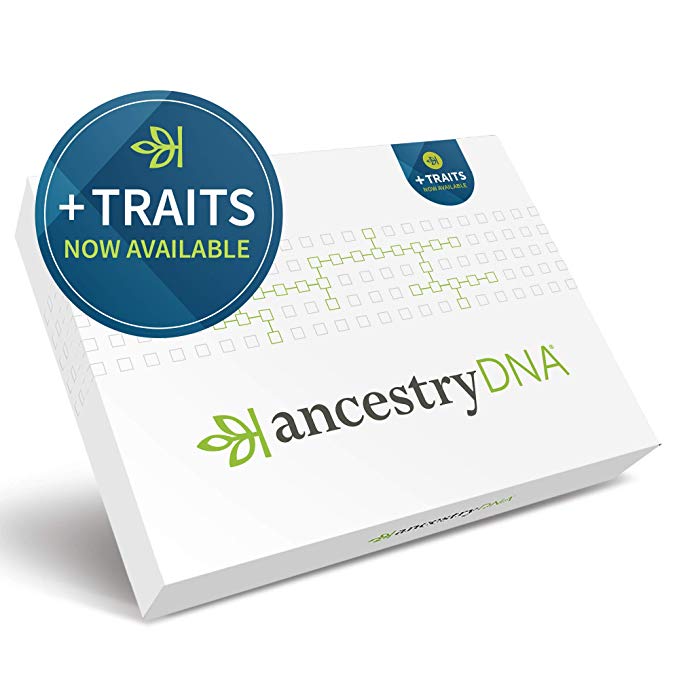 to allow only “invited guests” to your personal DNA party. (Read that post to be reminded why this is a good thing.)
to allow only “invited guests” to your personal DNA party. (Read that post to be reminded why this is a good thing.)
Ancestry has officially announced the launch of this feature update and reports that on average users will see an 80% reduction in the number of matches shown. I had a chance to look at the new site before it launched and one of my favorite features is the question mark that appears next to your match. Clicking on the question mark on your match page will bring up a menu of references to help you better understand the inner workings of matching at Ancestry, including those confidence levels that are a part of every relationship prediction. In this table below you can see that ancestry has tried to give you some fairly solid guidelines by which to assess the quality of your matches. You will want to focus on those matches with a confidence score of “High” or above to have the best chance of genealogical success. 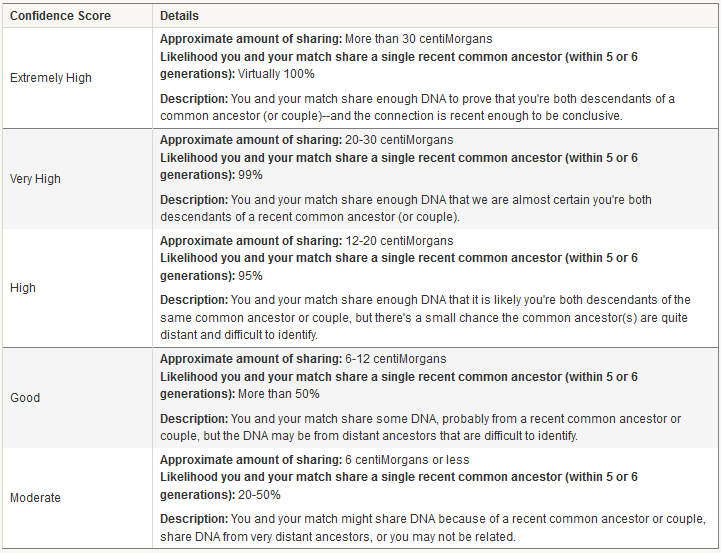 But an update to the matching feature is only the beginning of the new features at AncestryDNA
But an update to the matching feature is only the beginning of the new features at AncestryDNA. Today Ancestry announced “DNA Circles,” a tool that helps you identify others who share common ancestors with you. The new “DNA Circles” feature has the potential to impact the way you do genetic genealogy at Ancestry. Here’s why: Autosomal DNA (the kind that Ancestry is testing) has a spotty inheritance pattern. On average we only have half of the DNA of each of our parents, only 25% of our grandparents, only 12.5% of our great grandparents and so on. This means that AncestryDNA and its competitors (Family Tree DNA and 23andMe) are only able to genetically identify 50% of your genetic 4th cousins. This means that there could be 50% MORE people in these databases that you are actually related to, people that should have been invited to your DNA party, but didn’t have a ticket. Now with DNA Circles, there is a metaphorical “after-party.” After parties are “hosted” by one of your relatives. Ancestry searches your pedigree and that of your matches back 7 generations looking for suitable hosts. An ancestor qualifies as a host if they have two or more descendants who hold an invitation. At this after-party you can meet some of these long lost cousins that, while related to you, lost their ticket to your DNA party. After-party invitations are provided to those who meet three very important qualifications:
- They have their DNA attached to their PUBLIC family tree.
- AND that PUBLIC family tree has the name of the hosting ancestor on it.
- AND this person shares DNA with at least one other person who also meets the above two criteria.
Here’s an example. Below is an image of the new AncestryDNA home page. You can see I am a part of two DNA Circles (some of you will be much more popular and invited to several after-parties. For me–just the two for now). Let’s take a closer look at my DNA Circle hosted by my paternal 5th great grandfather Minus Griggs (who knew the guy liked parties?!).  Clicking on the DNA circle brings up this page where there are three things I want to show you:
Clicking on the DNA circle brings up this page where there are three things I want to show you: 
- This is your relationship to the host.
- This is a list of the individuals who have passed the three criteria listed above and have been invited to this after-party.
- This is the innovative part. You see that the first two matches (after me–I am listed first) have only “Tree Match” in this column. This means that these two people, both descendants of our host, Minus Griggs, didn’t ever appear on my DNA match list. We do not share enough DNA to be considered genetic relatives. However, the third member of the circle has the “DNA Match” designation, meaning that this match DOES appear on my match page. In fact, this is my ONLY DNA match in the circle (there are three others not shown here). That means that this DNA circle has connected me to FIVE other cousins. All because I share DNA and genealogy with the third member of this circle, and he shares DNA and genealogy with everyone else.
I can click on each circle member to see exactly how Ancestry THINKS we are related. This is my first opportunity to DOUBLE CHECK this relationship that Ancestry has handed me, to be sure that both my match and I really did receive tickets to the same after party.
Here is what that page looks like for me and one of my matches.
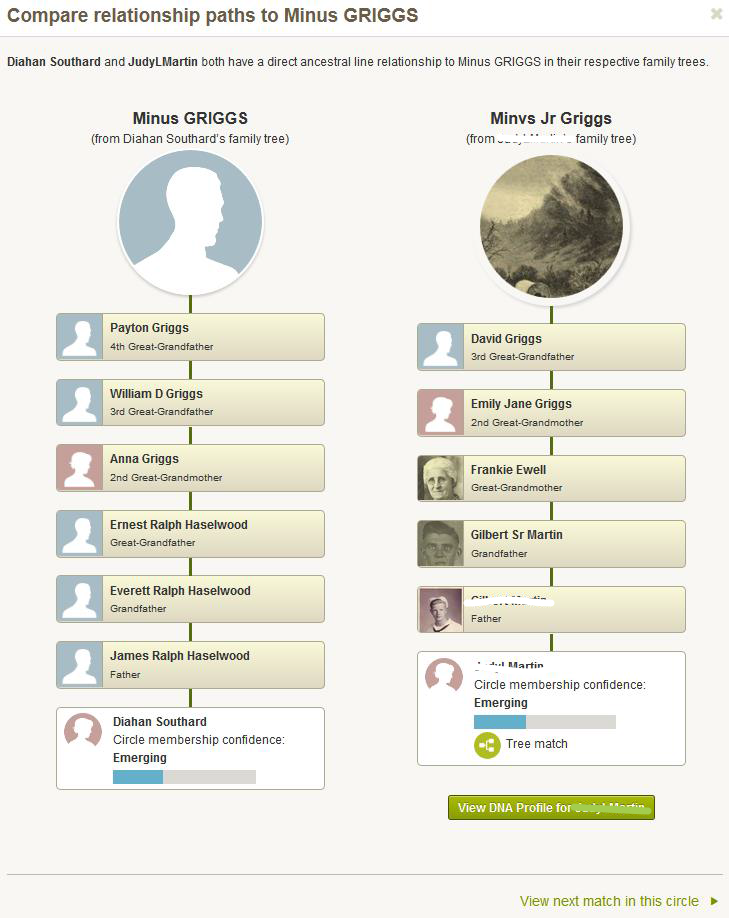 This is really the first time a DNA testing company has so fully integrated genetics and genealogy. We can now find cousins in the database who do not share our particular genetics, but who do share some of the genetics of our common ancestor. In my opinion, this is huge.
This is really the first time a DNA testing company has so fully integrated genetics and genealogy. We can now find cousins in the database who do not share our particular genetics, but who do share some of the genetics of our common ancestor. In my opinion, this is huge.
There is one catch, and it is going to be a big one for some of you. In order to see your DNA Circles, you have to be an Ancestry.com subscriber.
Even though I am excited about these changes, I can’t help but hope for just one step more. In order to identify these DNA Circles, Ancestry has identified pieces of DNA that can be fairly reliably assigned to a particular ancestor. There are likely others in the Ancestry database who have these pieces of DNA, we can call them partial tickets to the after-party, but who are lacking the second requirement: a pedigree documenting a relationship to that ancestor. I hope in the future the folks at Ancestry will honor those partial ticket holders, and allow them to the after-party, so we can sit around with our peanuts and pretzels and figure out how we are all related. Until then, I am going to enjoy the two after-parties hosted by my two generous ancestors.
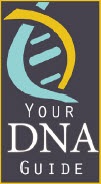 Ready to walk through the process of using DNA for your genealogy? Let me be your guide! Check out my quick
Ready to walk through the process of using DNA for your genealogy? Let me be your guide! Check out my quick  guides (left) Purchase each guide individually or pick up the bundle of all 4 for the best deal!
guides (left) Purchase each guide individually or pick up the bundle of all 4 for the best deal!
- Getting Started: Genetics for Genealogists;
- Y Chromosome DNA for Genealogists;
- Autosomal DNA for Genealogists; and
- NEW! Mitochondrial DNA for Genealogists.
Visit my website to learn about expert consultations with me. You’ll get customized guidance on which tests to order and how to maximize your results for your genealogy research.
